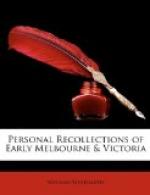The doctor was one of the most active of the colonists, both politically and generally. He was chiefly concerned in establishing the Geelong Corporation, of which he was several times Mayor, and he was most actively interested in the early representation of the district in the Sydney Assembly. He sat there as one of the district members prior to the “separation” session of 1851, and it was at his instance that the House made an exhaustive inquiry into the condition of the aboriginal natives. In the separation session elections his party was outvoted by the squatting or anti-democratic element; but none the less the former in Geelong deputed the doctor to accompany the elected members, in order to keep a watch upon their doings. The case had its comic aspect, but as the doctor and I were on the same side of the politics of the day, he was most useful to me in our common effort to secure a due share of representation for the mass of the people, as intended by the Imperial Government. The aim of the reigning regime was to continue their power by means of an electoral distribution which was to secure a majority of Crown nominees and Crown tenants in the two future sections of the old colony.
The doctor, as I said, went over with the earliest from the Hobart side of the island, quitting his land grant, which was the last under that system, and was got for him by his friend Governor Arthur—a privilege for which, as I have said, the Henty family arrived just too late. Amongst the live stock he took over was Miss Thomson’s pony, which was the first of the equines landed at Port Phillip. Its owner was then a very young girl. She and her mother landed towards the end of 1835, and were the first ladies of “the settlement.” The family pitched a tent almost under a magnificent gum tree, whose stump, covered with ivy, still exists close to the Cathedral at Prince’s Bridge. But shortly after several of the young men of the settlement, in order to provide them better accommodation, collected some boards and built them a hut lower down the river bank. With the two places the Thomsons were able to dispense hospitalities, their guests including Messrs. Gellibrand and Hesse, Mr. James Smith, and Mr. Mackillop. It used to be said that “the settlement” was in the habit of going to tea with Mrs. Thomson.
This brings us into 1836. The next year came the officials in charge from Sydney, who included Mr. R.S. Webb, as Collector of Customs, whose daughter, Annie, was the first white child born in the settlement (with, however, some dispute as to a blacksmith’s child having been the first), and who was afterwards married to my late friend, Colin Mackinnon, younger brother of the better known Lauchlan. Dr. Thomson used to read prayers to the little settlement in a rude structure upon the ground now occupied by St. James’s Church. Afterwards he removed to Kardinia, Geelong, as his live stock had been landed there, and this place he finally made his home.




